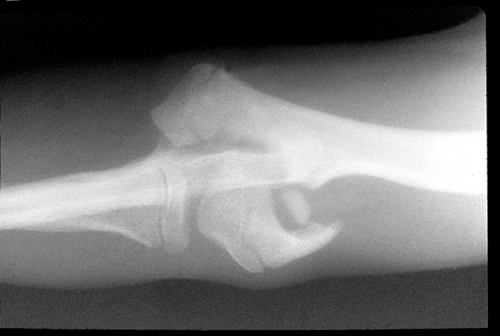Difference between revisions of "Small Animal Orthopaedics Q&A 07"
(Created page with "[[|centre|500px]] <br /> '''A radiograph of the elbow of a fivemonth-old, male Sharpei that jumped off of the porch and became non-weightbearing on this limb.''' <br /> <Flas...") |
|||
| (2 intermediate revisions by 2 users not shown) | |||
| Line 1: | Line 1: | ||
| − | [[|centre|500px]] | + | {{Manson |
| + | |book = Small Animal Orthopaedics Q&A}} | ||
| + | |||
| + | [[File:SmAnOrth 07.jpg|centre|500px]] | ||
<br /> | <br /> | ||
| Line 27: | Line 30: | ||
The classification scheme is more useful for describing the radiographic configuration of a particular physeal fracture. | The classification scheme is more useful for describing the radiographic configuration of a particular physeal fracture. | ||
| − | |l1= | + | |l1=Physeal Fractures#Salter-Harris Classification |
|q2=What is the Salter–Harris classification of this fracture? | |q2=What is the Salter–Harris classification of this fracture? | ||
|a2= | |a2= | ||
Salter–Harris type IV fracture of the lateral portion of the humeral condyle. | Salter–Harris type IV fracture of the lateral portion of the humeral condyle. | ||
| − | |l2= | + | |l2=Physeal Fractures#Salter-Harris Classification |
</FlashCard> | </FlashCard> | ||
Latest revision as of 12:04, 26 October 2011
| This question was provided by Manson Publishing as part of the OVAL Project. See more Small Animal Orthopaedics Q&A. |
A radiograph of the elbow of a fivemonth-old, male Sharpei that jumped off of the porch and became non-weightbearing on this limb.
| Question | Answer | Article | |
| Describe the Salter–Harris classification scheme for physeal fractures. | The Salter–Harris classification scheme was developed based on the relationship of the fracture line to the growing cells of physis and the radiographic appearance of the fracture. The classification scheme was developed to assist physicians in prognosticating disturbances of continued physeal growth in children.
The prognosis for continued growth is favorable with experimentally created type I, II and III fractures. The prognosis for continual growth is less favorable with type IV fractures unless the physis is accurately realigned. Type V injuries are associated with crushing of the cartilagenous growth plate and carry a poor prognosis for continued growth. Unfortunately, the prognostic accuracy of the Salter–Harris classification scheme is not reliable in dogs sustaining traumatically induced physeal fractures. The classification scheme is more useful for describing the radiographic configuration of a particular physeal fracture. |
Link to Article | |
| What is the Salter–Harris classification of this fracture? | Salter–Harris type IV fracture of the lateral portion of the humeral condyle. |
Link to Article | |
